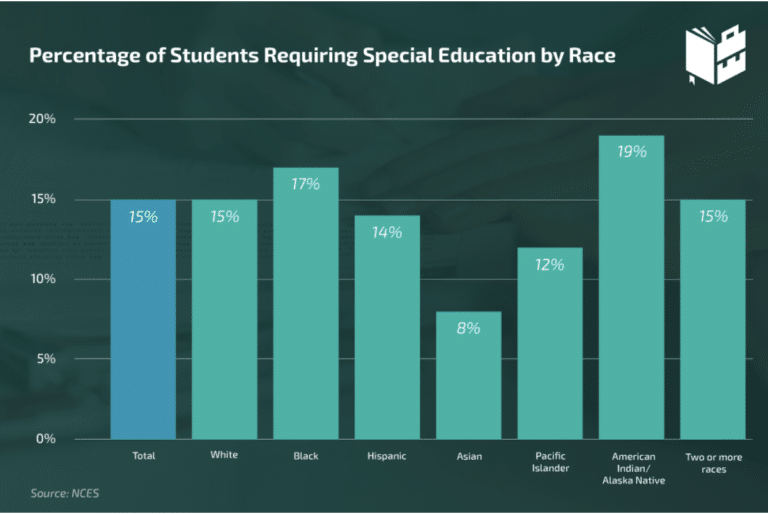


Providing accessible education to children with special needs is a battle that educators, academic institutions, and legislators have been carrying out since before the creation and implementation of what is known as the IDEA. And while we’ve seen many improvements since it was first introduced in 1975, there remain a multitude of special education problems we are not solving.
This article aims to shed light on these enduring issues in special education and delineate strategies in which they are being tackled at a federal or state level. Recognizing the importance of continuous improvement and advocacy, it is imperative to address these challenges and foster an environment that nurtures equal opportunities for the holistic development of all students.
In the demanding world of special education, burnout is an unfortunate and pervasive reality, impacting both staff wellbeing and student success. This free infographic, tailored specifically for current and aspiring special education leaders, presents a crucial resource in the fight against burnout at every level.

Budget constraints and discrepancies in resource allocation significantly impact the quality and scope of services provided to students with disabilities, affecting their post-school outcomes.
Fiscal-year budgets tend to be spent on severe disabilities, leaving out a sizeable part of the student body with IEPs. This requires continued advocacy for increased special education funding and more streamlined resource distribution for children with mild and mild to moderate disabilities on a national, state, and district level.
Schools face an acute teacher shortage, especially in the special education sector. According to NCES data from October 2022:
To mitigate this issue in special education, schools ought to enhance their staff’s professional development to increase retention rates and bridge gaps in critical positions. In September 2023, the US Department of Education awarded $35 million for the purpose of training teaching staff for more effective support for students with disabilities.
Examining racial and ethnic disparities alongside gender and socioeconomic gaps reveals a persistent pattern of disproportionality within special education.

Rachel Fish, a NYU Steinhardt Professor of Special Education, found in her 2022 study that:
Moreover, recent research has concluded that culturally and linguistically diverse students face difficulties and are often mislabeled based on inaccurate English-language comprehension screenings, grade retention, and lack of parental awareness regarding special education.
To combat such issues in special education, it is important to expose staff to relevant coaching on cultural and language diversity, equity, gender bias, and socioeconomic gaps, thus minimizing subjectivity in disability assessments and addressing unique learning needs.
A 2020 study published in the Journal of Disability Policy Studies indicated that inconsistencies in the implementation of laws across different states and districts often contribute to legal and compliance challenges, leading to disparities in the quality of services provided to students with disabilities. At the same time, lawsuits involving the transition of students with disabilities have increased steadily since 2004.
Programs such as Ori Learning aim to deliver high-quality, legally sound special education services to schools that establish baselines and scale students’ progress according to their IEP goals. This significantly aids special education directors to stay on top of compliance regulations and consolidates their strategies.
See what Ori Learning can do for your school or district
Often, students with special needs will struggle to complete standardized tests as they don’t fit their level of reading or computational comprehension. As EducationWeek noted:
A solution to this challenge is to implement an accessible curriculum that allows for the accommodation of diverse needs and various ways of assessment. The Universal Design for Learning (UDL) is one such approach that provides a flexible educational framework, accommodating diverse learning styles, disabilities, and special needs based on the following three principles:
Preparing students for life after school and increasing access to adult services and opportunities remain central to ensuring the long-term success of a special education program. According to the US Bureau of Labor Statistics:
Special education leaders should strive to implement comprehensive transition programs, establish strong community partnerships, and thus provide real-world training opportunities to equip students with the necessary skills and resources for independent living.
Some notable initiatives include Project SEARCH’s Transition-to-Work program, the Disability Innovation Fund’s Pathways for Partnerships, the Vermont Linking Learning to Careers initiative, etc.
Set your students up for success post-school and into adulthood by including these 4 key elements in your transition curriculum.

Key challenges include funding and resource allocation, teacher recruitment and retention, disproportionality, policy issues, standardized testing concerns, and post-school transition services.
Funding issues impact the quality of services for students with disabilities, with federal funds increasing to $15.5 billion but still not sufficiently addressing the needs of students with mild to moderate disabilities.
Efforts include enhancing professional development and a $35 million grant by the US Department of Education to train staff for better support of students with disabilities.
As we navigate the complex terrain of special education, it is essential to remain committed to the principles of equity, inclusivity, and continuous improvement. Here at Ori Learning, we are committed to creating a learning platform that reflects the diversity of our students, offers accessibility to content, and provides an inclusive environment where all learners can thrive.
We offer customized support to our district partners to meet individual needs and have extensive experience and success with research-based training and implementations that can scale and achieve strategic goals. Our platform is designed to be accommodating to a wide range of needs with features such as text enlargement, speech-to-text, read-aloud, as well as text translations into 130+ languages and read-aloud translation into 50+ languages.
Book a call with us today and together, let’s tackle the special education problems we are not solving by looking at them through a fresh, transformative perspective.

